
Soundgate App
EMAP Soundgate
Created by Rupert Till
Reader in Music at the University of Huddersfield

The Soundgate App allows you to interactively explore a number of archaeological sites as they might have looked in the ancient past. As well as seeing what they look like, you can also hear what they sounded like. Three World Heritage Sites are virtually modelled visually and sonically, including prehistoric caves in Spain; Stonehenge in England; and Paphos Theatre in Cyprus. While exploring these spaces, you can trigger musical sounds that may have been heard there in the past, and hear how the acoustics of the spaces enhances them, experiencing how the acoustics change as you move around the site. You can also virtually visit a number of wonderful places that are not usually accessible to the public. The Soundgate is intended to provide an experience of what it might have felt like to be in these places in the past. From the menu you can select three different archaeological sites to visit.
You can download the app at the following links:
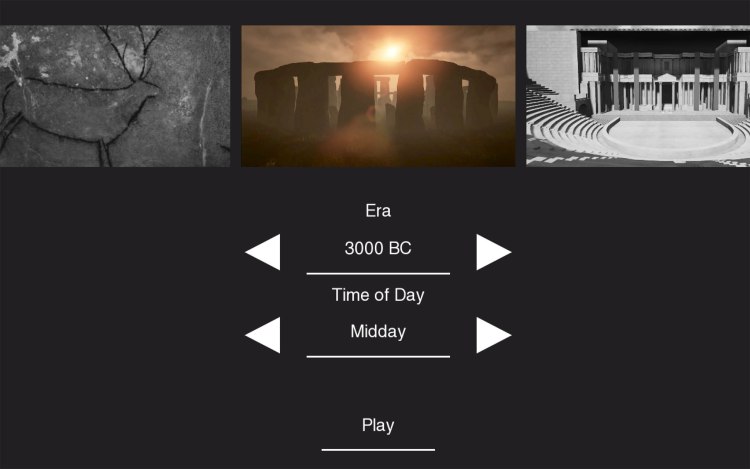
The first features caves that are part of the Cave of Altamira and Paleolithic Cave Art of Northern Spain World Heritage Site. They feature cave paintings created tens of thousands of years ago, enigmatic traces of early human art. 5 caves are featured, El Castillo, La Garma, Tito Bustillo, Las Chimeneas and La Pasiega. The paintings you will see range from 42,000 to 15,000 years old. The oldest are simple red dots.
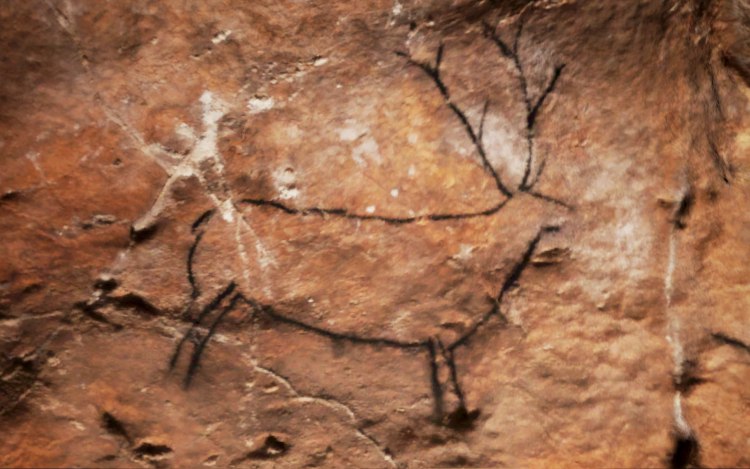
Generally the red images you will see are older than the black paintings, and the simple dots or hand shapes you might see are older than animal images. You might see deer, bulls, bison, horses and goats featured. The ancient explorers who ventured into this darkness in the past, would have had only small lamps that might provide about one metre of lighting, gently flickering burning animal fat, so this is the kind of lighting you will see in the model. We’ve made it so you have to hunt around a bit to see the paintings. However a video at the start will give you a quick guided tour. As you open each reconstructed cave model you will hear a sound recording that was made on site in the cave, and after that you will be able to play musical sounds by pressing buttons, and hear the acoustic effects of being in the cave. By the way, this will work better wearing headphones than using built in speakers. The digital models that were used to create the cave simulations are built from dozens of photographs that were taken in the caves and stitched together digitally.
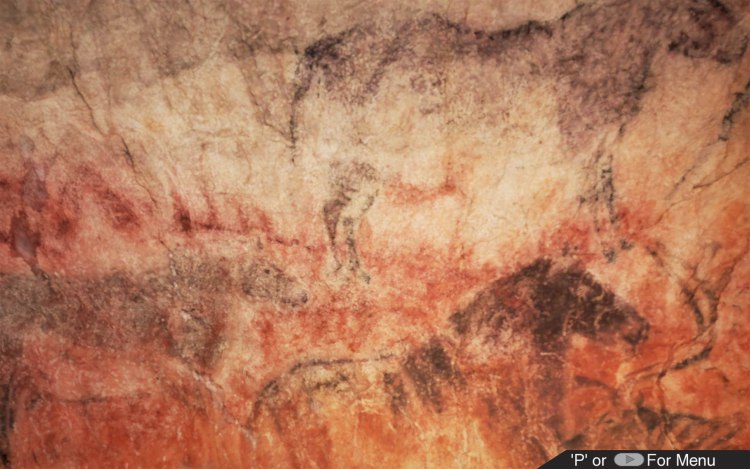
The second site you can visit from the menu page is Stonehenge, one of the most famous archaeological sites in the world. What can be seen of it today in Wiltshire in Southern England is only a ruin of the original site, with about half of the stones missing or fallen. Various phases of development of the site have been digitally rebuilt in the Soundgate so that you can experience what it might have been like to be there when it was first constructed. We can’t be absolutely sure exactly how it was arranged, but archaeologists now have a pretty good idea, although what you see is only one interpretation, it may have been slightly different. You can begin by exploring Stonehenge as it was more than 5000 years ago, about 3000 BC, when there was basically just a circular ditch with a bank inside. A large standing stone, the Heel stone may have been there at the time, we are not sure when this arrived, or if it is a natural feature. The first stone circle created at Stonehenge is featured in a second model you can select. This is from around 2900BC. About this time, a circle of Aubrey Holes was dug inside the bank, and it is now thought that bluestones, brought hundreds of miles from Wales, were placed in these holes. Perhaps these stones marked some kind of relationship between the English locals and people in Wales. Cremated remains of people have been found in the holes, so it seems that Stonehenge was a kind of cemetery, or home for the ancestors, at least at this time. The third reconstruction of the site is dated 2500 BC, and at this point we start to see huge local stones called sarsens arranged in a circle with lintels on the tops. Trilithons are also added, giant pairs of stones with a third stone on top, looking almost like a doorway. The fourth and final phase is dated to about 2200 BC, with the bluestones rearranged amongst the larger Sarsen stones. This is the final stage of development of the site.
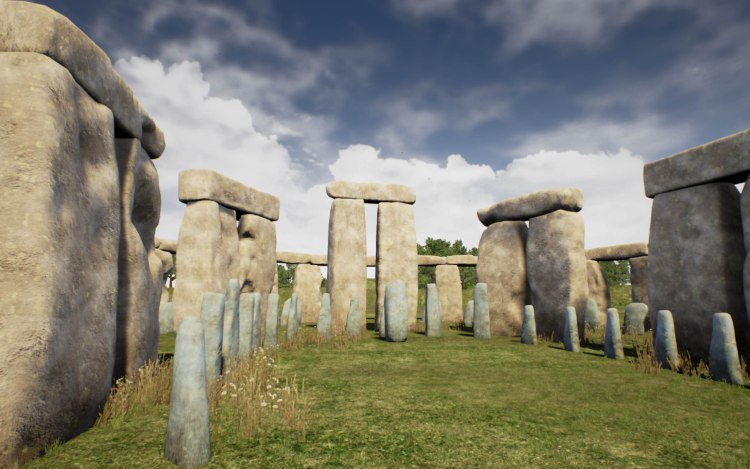
At Stonehenge you can press a button to trigger the sound of a reconstruction of an ancient bird bone flute, the Wilsford flute. This object was dug up by archaeologists nearby, and has a similar date to Stonehenge. So it is possible that the original archaeological find was played inside Stonehenge, or that something similar was played there as part of a sacred ceremony. Perhaps the ancestors were consulted for healing, visitors travelling to this home of the dead to find solutions to their problems. You can also hear a wooden drum being played, as well as local songbirds and crows. In the different parts of the site, you will hear echoes reflecting off the stones, especially when you move inside the stone circle. You can choose to see the model of Stonehenge as it might look in the daytime, in the evening, or at night. At night you can hear different birds, the owl, nightingale and corncrake, birds that were more common in the past.

The third site you can select in the menu is another world heritage site, Paphos Theatre in Cyprus. The version modelled here is Roman, dated from between 300 BC and 500 AD. The theatre is near the sea, and if you listen carefully you might hear waves in the distance, along with the wind fluttering in the material of the theatre’s canopy and curtains, and perhaps some seagulls. You might also hear pigeons and doves, birds we know the Romans used to eat, as well as local birds the Cyprus Warbler and Cyprus Wheatear. You can also trigger the sound of two Roman musical instruments with buttons, the double pipe (also known as the tibia), and the lituus. Playing double pipes was like putting two oboes in your mouth and playing them at once, except that you used circular breathing so you could continue playing. This involves using your cheeks to blow air out, while breathing in through your nose at the same time. The Lituus is a long bronze tube with a curved bell at the end, and sounds a little like a trumpet. As you move away from the front you will hear more of the reverberation of the theatre, as if the instruments are being played at the front.
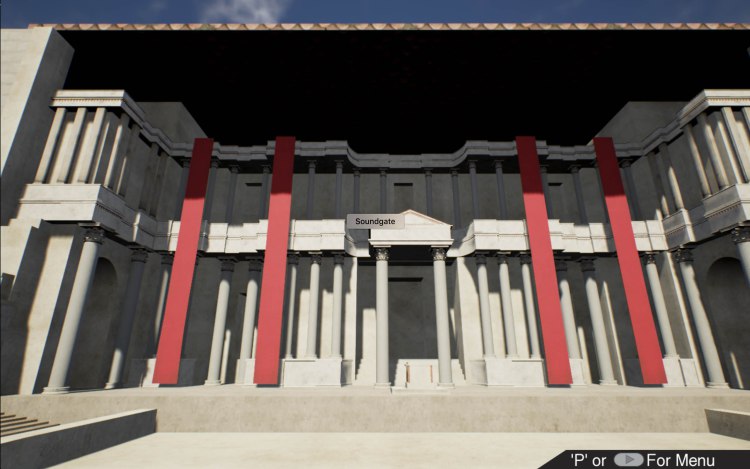
Controls
Touchscreen:
To navigate, tap the screen to go to a selected point, or pinch and drag.
Press the icons to play sounds or return to the menu
Mac and PC Version
If using an XBox or similar controller:
Menu:
Use the left joystick to navigate. Use x, the bottom button on the right to select
When Viewing the Sites:
Move using left joystick, look around with the right joystick. Other buttons play and stop sounds. Start takes you back to the menu.
If using a keyboard:
W/S/A/D buttons allow you to to move around, you can also try the arrow keys on some systems. Number buttons trigger sounds. Mouse or trackpad allow you to look around.
Credits:
Project direction and audio development by Rupert Till
The project was supported by the University of Huddersfield and the Culture Programme of the European Union.
Caves:
Shakers, cow horns, and and an Isturitz pipe reconstruction played as a flute, are made and played by Simon Wyatt. The Isturitz pipe was a flute like instrument made of vulture bone, found in the Isturitz cave in France, the original object was made around 20,000 years ago.
The drums, played by Rupert Till and Raquel Jimenez, are replicas of a Mansi drum from west Siberia, collected by Artturi Kannisto in 1906, made from spruce wood and reindeer skin by Juhana Nyrhinen in Finland. This is the sort of drum used by Shamen.
Local sea shells are played by Raquel Jimenez.
A reconstruction of the Isturitz pipe is played with a reed by Carlos Garcia.
A bull roarer is played by Manolo Rojo. This is a prehistoric instrument whirled around your head, which is still played by Australian Aboriginal people.
Stonehenge:
Frame drum, as played in the caves.
Wilsford Flute reconstruction, made and played by Simon Wyatt. Archaeologists found a bone flute which was made at about the same time Stonehenge was built, in the Wilsford Shaft, a deep pit discovered near Stonehenge with various objects buried in it.
Paphos Theatre:
The Lituus bronze horn you can hear was made by Peter Holmes and played by John Kenny.
The double pipes, also known by the Greeks as Aulos and by the Romans as Tibia, are played by Stefan Hagel.
Modelling
Digital graphical and interactive modelling by Andrew Taylor, Ertu Unver, Tom Bullard, Daniel Carter, Jordan Bolton, Matthew Bingham, Shiv Devani, Nick Chilvers and Parampal Singh.
Caves:
The caves part of the project is based on the Songs of the Caves project, a collaboration between Rupert Till of the University of Huddersfield, Chris Scarre of the University of Durham and Bruno Fazenda of the University of Salford. Also involved in the project were Aaron Watson, Simon Wyatt, Raquel Jimenez, Carlos Garcia and Manuel Rojo Guerra.
Access to the caves was only possible through the kind support of Roberto Ontañón Peredo of Roberto Ontañón Peredo of the Museo de Prehistoria y Arqueología de Cantabria, and both the Gobierno de Cantabria and Gobierno Del Principado de Asturias.
The Songs of the Caves project was funded by the Arts and Humanities Research Council and the Engineering and Physical Sciences Research Council as part of the Heritage Science programme.
Photogrammetric models of the caves were created by Aaron Watson.
Stonehenge:
English Heritage provided the original point cloud data that was the starting point of the models of Stonehenge. Lidar data was used to provide accurate ground contours.
Further information is available at soundsofstonehenge.wordpress.com
Paphos Theatre:
The Cyprus Institute provided the initial archaeological model on which this reconstruction was based.


